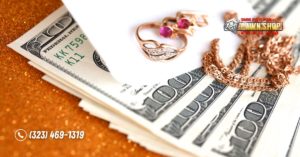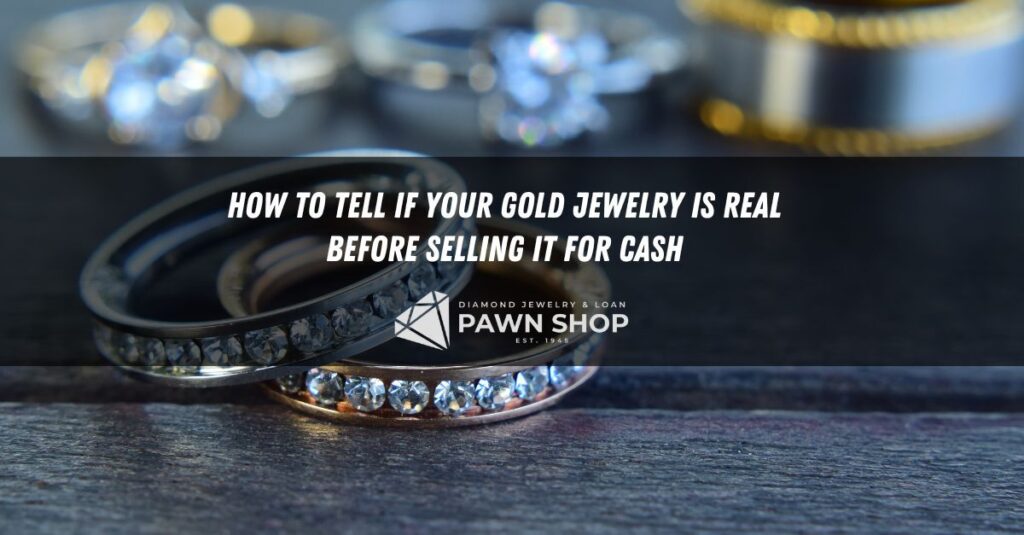Low on cash and need it fast? You’re not alone. Many people turn to selling gold jewelry when they need quick money, but there’s one crucial step you can’t skip: verifying that your gold is genuine before you walk into any cash jewelry and loan shop.

Fake gold jewelry has flooded the market over the past decade. From convincing costume pieces to deliberately deceptive counterfeits, it’s easier than ever to mistake worthless metal for the real deal. The good news? You can learn to spot authentic gold using simple tests you can do at home.
This guide will walk you through proven methods to authenticate your gold jewelry, help you understand what affects its value, and show you how to get the best price when you’re ready to sell. By the end, you’ll have the confidence to separate your real gold from the fakes and make informed decisions about your jewelry.
Why Authenticity Matters When Selling Gold
Gold prices fluctuate daily, but genuine gold always holds intrinsic value. When you walk into a pawn shop or cash jewelry and loan business, they’ll test your pieces anyway. Knowing your gold’s authenticity beforehand saves you from embarrassment and helps you negotiate from a position of knowledge.
Real gold jewelry contains varying percentages of pure gold, measured in karats. Pure gold is 24 karats, but most jewelry ranges from 10k to 18k gold. The higher the karat, the more valuable your piece becomes. Gold-plated, gold-filled, or completely fake pieces have little to no resale value.
Visual Inspection: Your First Line of Defense
Before diving into physical tests, examine your jewelry carefully under good lighting. Authentic gold maintains its color and luster over time, while fake gold often shows signs of wear that give it away.
Check for Hallmarks and Stamps
Look for tiny stamps or engravings on your jewelry. These hallmarks typically appear on the inside of rings, the clasp area of necklaces, or the back of earrings. Common markings include:
- Karat stamps: 10k, 14k, 18k, or 24k
- Fineness numbers: 417 (10k), 585 (14k), 750 (18k), or 999 (24k)
- International marks: “GF” (gold-filled), “GP” (gold-plated), or “HGE” (heavy gold electroplate)
Be cautious of pieces with no markings at all, as well as those stamped with obviously fake marks like “24KGP” (24-karat gold-plated).
Examine the Color and Wear Patterns
Real gold doesn’t tarnish or rust. If you notice green or black discoloration on your skin after wearing the jewelry, or if the piece itself shows signs of tarnishing, it’s likely fake or heavily mixed with other metals.
Pay attention to high-wear areas like the inside of rings or areas where chains rub against clasps. If you see different colored metal showing through, your jewelry is probably gold-plated rather than solid gold.
Simple At-Home Tests for Gold Authentication
The Magnet Test
Gold is not magnetic, so this test can quickly eliminate obvious fakes. Use a strong magnet (not a refrigerator magnet) and hold it close to your jewelry. If the piece is attracted to the magnet, it contains significant amounts of ferromagnetic metals and is not solid gold.
Keep in mind that this test isn’t foolproof. Some fake gold pieces use non-magnetic metals, so passing the magnet test doesn’t guarantee authenticity.
The Skin Test
Wear the jewelry for a few hours and check your skin afterward. Fake gold often contains nickel, copper, or other metals that can leave green or black marks on your skin. While this test takes time, it’s particularly effective for rings and bracelets.
The Ceramic Test
Find an unglazed ceramic tile or the unfinished bottom of a ceramic mug. Gently scratch your gold piece across the ceramic surface. Real gold will leave a golden streak, while fake gold will leave a black or different colored mark.
Use caution with this test, as it can damage your jewelry. Only scratch in an inconspicuous area, and apply very light pressure.
Professional Testing Methods
When you’re ready to sell, professional buyers use more sophisticated methods to verify gold authenticity and purity.
Acid Testing
Professional gold buyers use acid testing kits with different strength acids for various karat levels. They make a small scratch on your jewelry and apply drops of acid. The reaction (or lack thereof) indicates the gold’s purity level.
Electronic Gold Testing
Modern pawn shops and cash jewelry and loan businesses often use electronic gold testers. These devices send a small electrical current through the metal and measure conductivity to determine gold content. This method is non-destructive and highly accurate.
X-Ray Fluorescence (XRF) Testing
High-end buyers use XRF machines that can analyze the exact composition of your jewelry without damaging it. This technology provides precise measurements of gold content and identifies other metals present in the alloy.
Understanding Gold Value Beyond Authenticity
Once you’ve confirmed your jewelry is real gold, several factors affect its cash value:
Weight matters most. Gold is typically priced per gram or pennyweight. Heavier pieces are worth more, assuming the same karat level.
Karat content determines purity. Higher karat gold contains more pure gold and commands higher prices per gram.
Craftsmanship can add value. While most buyers focus on gold content, exceptional craftsmanship or designer pieces might earn premium prices.
Market conditions affect pricing. Gold prices fluctuate based on economic conditions, so timing your sale can impact your return.
Red Flags to Watch For
Certain characteristics almost always indicate fake gold:
- Jewelry that feels unusually light for its size
- Pieces that are strongly magnetic
- Items with obvious color variations or wear patterns
- Jewelry with no hallmarks or suspicious markings
- Pieces that cause skin discoloration
- Gold that tarnishes or changes color over time
Getting the Best Price for Your Gold
When you’re confident your jewelry is authentic, shop around before selling. Different cash jewelry and loan shops offer varying prices based on their overhead, customer base, and business model.
Get quotes from multiple buyers, including pawn shops, jewelry stores, and online gold buyers. Ask about their testing methods and pricing structure. Reputable buyers will test your gold in front of you and explain their pricing clearly.
Consider the current gold market price (spot price) when evaluating offers. While you won’t receive the full spot price (buyers need profit margin), offers significantly below market value might indicate you should look elsewhere.
Making Your Final Decision
Armed with knowledge about your gold’s authenticity and value, you can make confident decisions about selling. Remember that reputable cash jewelry and loan businesses want to build long-term relationships with customers, so they’ll typically offer fair prices and transparent testing.
If you’re still unsure about your jewelry’s authenticity, consider getting a professional appraisal before selling. While this costs money upfront, it can potentially save you from selling valuable pieces too cheaply or help you avoid embarrassment if pieces turn out to be fake.
The key to successful gold selling lies in preparation and knowledge. By testing your jewelry beforehand and understanding what affects its value, you’ll be ready to negotiate confidently and get the cash you need quickly and fairly.


